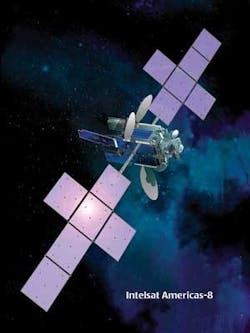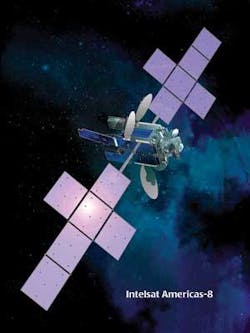Intelsat satellite fleet supports offshore, maritime markets
Each day, the world’s leading communications service providers promise uninterrupted connectivity to their clients in the offshore and maritime markets. But before that promise can be made, those service providers need the assurance that highly reliable, flexible satellite capacity will be available whenever it’s needed.
Intelsat, as the world’s largest provider of fixed satellite services, has been providing those assurances for decades - enabling service providers to offer the latest broadband, IP-based voice, video, data and Internet packages to offshore drilling rigs and production facilities, cargo vessels, cruise ships and luxury yachts.
As they serve offshore structures and remote energy facilities on land, Intelsat’s customers depend not only on the company’s global network and high reliability, but also on its quick response and proactive approach. The ground facilities that monitor and control its fleet of 51 satellites are complemented by the company’s terrestrial network of eight owned teleports, more than 50 points of presence and leased fiber links. Intelsat’s monitoring capability, combined with its expert staff, allows it to react quickly when resolving issues or troubleshooting.
With the need to communicate reliably to and from remote locations, often under harsh conditions, companies such as CapRock Communications, Schlumberger, SkyPort and RigNet rely on Intelsat’s robust network. The company’s satellite fleet can reach virtually anywhere in the world and its terrestrial connections span three continents. This system supports complex networking solutions to keep vessels and stabilized platforms connected to their servers and mainframes for reporting and receiving data - enabling real-time decision making.
Founded in 1964, Intelsat maintains a robust fleet of satellites that provide advanced services to more than 1,800 customers, including many of the world’s leading offshore and maritime companies, media and broadcasting organizations, multinational corporations, telecommunications companies, and government/military entities.
Earlier this year, Intelsat completed its acquisition of PanAmSat, one of its largest rivals. The company’s combined satellite fleet is complementary and covers more than 99% of the world’s populated regions. The fleet is maintained with a fully integrated satellite operations protocol that features two operations centers connected by redundant fiber, which results in a robust monitoring and control system.
Many of Intelsat’s satellites in orbital locations outside North America have steerable beams that can be reconfigured to provide different areas of coverage, and many can be relocated to other orbital locations. That flexibility enables the company to respond rapidly to changes in market conditions and resulting customer demand.
Connectivity for cruise ships, luxury yachts
Intelsat satellites make it possible for customers such as Maritime Telecommunications Network (MTN) to serve more than 90% of the global cruise line sector. This satellite reliability enables MTN to offer vessel monitoring and onboard transmissions that include WiFi broadband access, Internet cafes, automatic teller machine (ATM) service, and access to leading daily newspapers, cellular phones and television services.
In August 2006, Intelsat announced that Station 53, a supplier of integrated communications services to luxury yachts, signed a multi-year agreement to provide voice-over Internet protocol (VoIP), data and Internet service through Intelsat’s GlobalConnex managed network. Station 53 is the first maritime service provider to sign such an agreement with Intelsat as a company dedicated exclusively to providing communications services to the luxury yacht market.
Station 53 will use Intelsat’s Network Broadband Service to provide luxury yachts sailing in the Caribbean and the Mediterranean with high-speed Internet access at throughputs higher than DSL connections. Both networks, one for Caribbean and one for Mediterranean connectivity, operate simultaneously as the luxury yachts migrate seasonally between regions.
The service is provided out of Intelsat’s Mountainside Teleport facility on the U.S. east coast, using its IS-905 satellite located at 335.5° E. longitude. By serving both regions on a single satellite, Intelsat provides Station 53 with a cost-effective, bundled solution that simplifies the seasonal transition from one ocean region to another.
Prior to signing with Intelsat, Station 53’s services were operating on multiple networks with multiple service providers, limiting its ability to fully manage its network. Intelsat has provided a single-source solution for all of Station 53’s customer communications needs. The yachting community now has the luxury of surfing the Internet, calling home via VoIP, or running their businesses from the comfort of their own boats whenever they’re sailing in these regions.
Disaster recovery for business, government
The past few years have provided a strong reminder of the important contribution satellites can make during dire situations. Some of the largest players in the offshore and maritime markets - in addition to many local governments - are making new investments in mobile and fixed satellite products to ensure redundant communications are available when disaster strikes.
Local, state and federal government agencies have become increasingly aware of the need for satellite communications equipment and capacity in the event of natural disaster or terrorist attack. It has been proven that traditional wireline and cellular communications will not be reliable in these disasters.
After the 2005 hurricanes that so adversely affected the Gulf of Mexico offshore industry, satellite communications played a critical role. When the land-based telephone and broadcast networks went down, satellites remained on the job, providing redundancy, ubiquity and resiliency that were unavailable from land-based networks.
Satellites first warned of the impending danger. Afterward, satellites connected emergency personnel and other first responders. They reunited families and reconnected communities. Then, they helped to enable the world to witness the devastation of these disasters, as well as the many associated acts of heroism.
The importance of planning for redundancy to terrestrial systems, and for pre-positioning equipment for rapid deployment, cannot be overemphasized. The satellite industry was not as affected - as land-based networks were - by the hurricanes. While the outages on land-based networks surged in the days following the storms, satellite networks were experiencing a corresponding surge in demand for capacity.
Satellite providers stepped in quickly to provide emergency voice, video, and data communications. Intelsat reconfigured capacity, and in some cases donated service, to help wireless providers re-establish their networks and to provide capacity for the Dept. of Homeland Security and FEMA.
Additionally, PanAmSat - now part of Intelsat - donated capacity to the Red Cross to provide communications to 40 of their sites and to specially equipped Red Cross mobile units. Other satellite operators donated capacity to enable high-speed, ship-to-shore communications for ships carrying disaster relief teams to the flooded areas of New Orleans.
For more information contact Intelsat at 202-944-7634; Web site:www.intelsat.com; email: [email protected].

